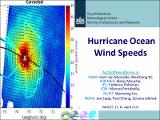Por favor, use este identificador para citar o enlazar a este item:
http://hdl.handle.net/10261/257854COMPARTIR / EXPORTAR:
 SHARE
BASE SHARE
BASE
|
|
| Visualizar otros formatos: MARC | Dublin Core | RDF | ORE | MODS | METS | DIDL | DATACITE | |

| Título: | Hurricane Ocean Wind Speeds |
Autor: | Stoffelen, Ad; Marseille, Gert-Jan; Ni, Weicheng; Mouche, Alexis Aurélien; Polverari, Federica CSIC ORCID; Portabella, Marcos CSIC ORCID ; Lin, Wenming CSIC ORCID; Sapp, Joe; Chang, Paul; Jelenak, Zorana | Fecha de publicación: | abr-2021 | Citación: | 15th International Winds Workshop (2021) | Resumen: | How strong does the wind blows in a hurricane proves a question that is difficult to answer, but has far-reaching consequences for satellite meteorology, weather forecasting and hurricane advisories. Moreover, huge year-to-year variability in extremes challenges evidence for changing hurricane climatology in a changing climate. Tropical circulation conditions, such as El Nino and the Madden Julian Oscillation, are associated with the large year-to-year variability and their link to climate change is poorly understood, though of great societal interest. Since hurricanes are sparsely sampled, satellite instruments are in principle very useful to monitor climate change. However, their stability over time in quality and quantity (sampling) needs to be guaranteed. Moreover, to use the longest possible satellite record, satellite instrument intercalibration of the extremes is needed [6]. This applies for a single instrument using a single processor version (calibration, Quality Control, Geophysical Model Function, retrieval) for change detection over a decade typically and the use of overlapping single-instrument/single-processor series for climate analyses. Currently, systematic inconsistencies in the extremes exist, as illustrated within the European Union (EU) Copernicus Climate Change Windstorm Information Service (C3S WISC) and European organisation for the exploitatrion of Meteorological Satellites (EUMETSAT) C-band High and Extreme-Force Speeds (CHEFS) projects. Besides for the scatterometers ERS, QuikScat, HSCAT and OSCAT, these instrument series may be extended to passive microwave wind instruments from 1979, if proven reliable at the extremes? In the EUMETSAT CHEFS project, KNMI, ICM and IFREMER worked with international colleagues to improve the detection of hurricane-force winds. To calibrate the diverse available satellite, airplane and model winds, in-situ wind speed references are needed. Unfortunately, these prove rather inconsistent in the wind speed range of 15 to 25 m/s, casting doubt on the higher winds too. However, dropsondes are used as reference operationally at high and extreme winds in nowcasting and in the European Space Agency (ESA) project MAXSS satellite intercalibration is further investigated based on dropsondes to serve this community. However, from a scientific point of view, we should perhaps put more confidence in the moored buoy references? This would favor accuracy in drag parameterizations and physical modelling and observation of the extremes. This dilemma will be presented to initiate a discussion with the international community gathered at EGU ’21 | Descripción: | 15th International Winds Workshop, 12-16 April 2021.-- 22 pages | URI: | http://hdl.handle.net/10261/257854 |
| Aparece en las colecciones: | (ICM) Comunicaciones congresos |
Ficheros en este ítem:
| Fichero | Descripción | Tamaño | Formato | |
|---|---|---|---|---|
| Stoffelen_et_al_2021_presentation.pdf | 2,5 MB | Adobe PDF |  Visualizar/Abrir |
CORE Recommender
NOTA: Los ítems de Digital.CSIC están protegidos por copyright, con todos los derechos reservados, a menos que se indique lo contrario.
